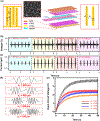Implanted Battery-Free Direct-Current Micro-Power Supply from in Vivo Breath Energy Harvesting
- PMID: 30444344
- PMCID: PMC6456428
- DOI: 10.1021/acsami.8b15619
Implanted Battery-Free Direct-Current Micro-Power Supply from in Vivo Breath Energy Harvesting
Abstract
In vivo biomechanical energy harvesting by implanted nanogenerators (i-NGs) is promising for self-powered implantable medical devices (IMDs). One critical challenge to reach practical applications is the requirement of continuous direct-current (dc) output, while the low-frequency body activities typically generate discrete electrical pulses. Here, we developed an ultrastretchable micrograting i-NG system that could function as a battery-free dc micro-power supply. Packaged by a soft silicone elastomer with a cavity design, the i-NG exhibited an ultralow Young's modulus of ∼45 kPa and a high biocompatibility to soft biological tissues. The i-NG was implanted inside the abdominal cavity of Sprague Dawley adult rats and directly converted the slow diaphragm movement during normal respiration into a high-frequency alternative current electrical output, which was readily transmitted into a continuous ∼2.2 V dc output after being integrated with a basic electrical circuit. A light-emitting diode was constantly operated by the breath-driven i-NG without the aid of any battery component. This solely biomechanical energy-driven dc micro-power supply offers a promising solution for the development of self-powered IMDs.
Keywords: battery-free system; direct-current micro-power source; energy harvesting from respiration; implantable medical devices; implantable nanogenerator.
Conflict of interest statement
The authors declare no competing interests.
Figures




Similar articles
-
Instantaneous Piezoelectric Nanogenerator for Pacemaker Applications.Nano Energy. 2025 Jun 1;138:110828. doi: 10.1016/j.nanoen.2025.110828. Epub 2025 Mar 1. Nano Energy. 2025. PMID: 40161363
-
Study of Long-Term Biocompatibility and Bio-Safety of Implantable Nanogenerators.Nano Energy. 2018 Sep;51:728-735. doi: 10.1016/j.nanoen.2018.07.008. Epub 2018 Jul 6. Nano Energy. 2018. PMID: 30221128 Free PMC article.
-
In vivo powering of pacemaker by breathing-driven implanted triboelectric nanogenerator.Adv Mater. 2014 Sep 3;26(33):5851-6. doi: 10.1002/adma.201402064. Epub 2014 Jul 17. Adv Mater. 2014. PMID: 25043590
-
Advanced Implantable Biomedical Devices Enabled by Triboelectric Nanogenerators.Nanomaterials (Basel). 2022 Apr 15;12(8):1366. doi: 10.3390/nano12081366. Nanomaterials (Basel). 2022. PMID: 35458075 Free PMC article. Review.
-
Implantable Energy-Harvesting Devices.Adv Mater. 2018 Nov;30(44):e1801511. doi: 10.1002/adma.201801511. Epub 2018 Jul 24. Adv Mater. 2018. PMID: 30043422 Review.
Cited by
-
Materials Perspectives for Self-Powered Cardiac Implantable Electronic Devices toward Clinical Translation.Acc Mater Res. 2021 Sep 24;2(9):739-750. doi: 10.1021/accountsmr.1c00078. Epub 2021 Aug 23. Acc Mater Res. 2021. PMID: 35386361 Free PMC article.
-
Stretchable Encapsulation Materials with High Dynamic Water Resistivity and Tissue-Matching Elasticity.ACS Appl Mater Interfaces. 2022 Apr 27;14(16):18935-18943. doi: 10.1021/acsami.2c03110. Epub 2022 Apr 15. ACS Appl Mater Interfaces. 2022. PMID: 35426654 Free PMC article.
-
From Triboelectric Nanogenerator to Polymer-Based Biosensor: A Review.Biosensors (Basel). 2022 May 11;12(5):323. doi: 10.3390/bios12050323. Biosensors (Basel). 2022. PMID: 35624624 Free PMC article. Review.
-
Biodegradable Piezoelectric Polymers: Recent Advancements in Materials and Applications.Adv Healthc Mater. 2023 Sep;12(23):e2300318. doi: 10.1002/adhm.202300318. Epub 2023 Jun 9. Adv Healthc Mater. 2023. PMID: 37235849 Free PMC article. Review.
-
Self-powered technology based on nanogenerators for biomedical applications.Exploration (Beijing). 2021 Sep 1;1(1):90-114. doi: 10.1002/EXP.20210152. eCollection 2021 Aug. Exploration (Beijing). 2021. PMID: 37366464 Free PMC article. Review.
References
-
- Goldberger Z; Lampert R, Implantable Cardioverter-defibrillators: Expanding Indications and Technologies. Jama 2006, 295, 809–818. - PubMed
-
- Goldstein D; Oz M; Rose E, Medical Progress: Implantable Left Ventricular Assist Devices 1522. New England Journal of Medicine-Unbound Volume 1998, 339. - PubMed
MeSH terms
Grants and funding
LinkOut - more resources
Full Text Sources

